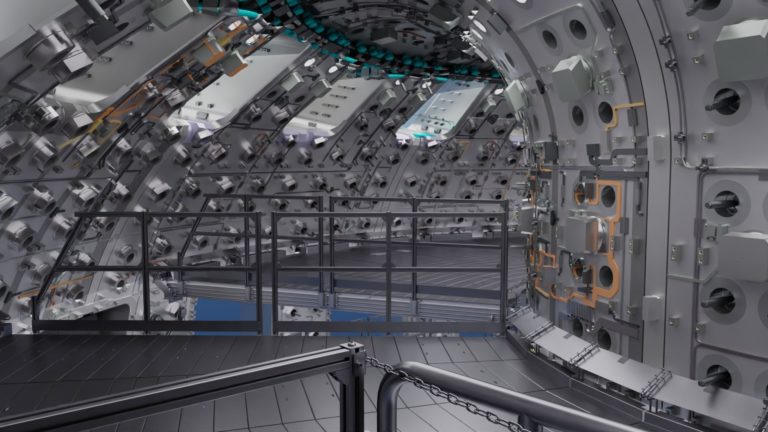Materials for nuclear fusion: how do you confine a sun to a box?
Friday 18th May 2018, 2.57pm
We face an energy crisis, so the idea of a clean, potentially limitless supply of energy is deeply appealing. Nuclear fusion, the same source of energy that makes the sun shine, could provide the answer, but there are some big obstacles to overcome.
Nuclear fusion – energy of the future?
Modern nuclear power plants produce power from the energy produced during nuclear fission, where heavy and unstable atoms are split open. Typically, a neutron will react with an atom of Uranium-235 to produce two smaller atoms, for example Rubidium and Caesium, plus three neutrons. The three neutrons then go on to split more Uranium atoms, which go on to produce more neutrons, which go on to split more atoms…. This chain reaction can be controlled in a fission reactor to maintain a steady state, from which we get controlled heat and power production.
Nuclear fusion is the opposite process; atoms are stuck together, rather than split apart. Fusion reactions that produce elements lighter than iron release energy in an exothermic (energy out) process. If you try and fuse any heavier elements, then you will find you will need more energy to make them stick together than you get out of the reaction.
The most energy productive fusion reaction is the “DT” reaction between two isotopes of hydrogen (atoms with more neutrons than hydrogen, but the same number of protons). Deuterium (D) has two neutrons, and tritium (T) has three. Deuterium and tritium react to produce helium and a neutron.
The energy produced by this reaction is less than the fission reaction, but the energy per nucleon (a neutron or proton) is far greater. Which means if you consider the same mass of fuel, fusion produces much more energy. There is enough of this fusion fuel to last millions of years, and it produces no long lived radioactive waste products.
How do we do it?
Uranium-235 is relatively easy to split in a fission reaction due to the chain reaction process. Each fission event will produce three neutrons, which will trigger three more events, and so on. This can be controlled by limiting the number of neutrons available for new fission reactions using moderators.
Fusion on the other hand is quite tricky to make happen. To fuse two elements, first we need to overcome the electrical repulsion of the nuclei. They are both positively charged, so will repel like two magnets repel each other when faced with the same pole. To overcome this repulsive barrier, we need to put a large amount of energy into the deuterium and tritium, so they can get close enough for the strong force to take over (the force that glues an atomic nucleus together). This ultimately amounts to heating up a mixture of deuterium and tritium to a few hundred million degrees Celsius – no easy task.

The most promising design for a fusion reactor is called a tokamak, which is a doughnut shaped reactor with a complex magnetic field configuration. The magnetic field confines the charged DT gas (plasma) while microwaves and neutral beams bombard the plasma. This allows the DT mixture to reach over 100 million degrees (hotter than the sun!), at which point a useful proportion of the DT ions have enough energy to fuse together. The main goal is to have enough of these fusion reactions occurring so that the energy coming out exceeds the energy we put in to heat it up in the first place. Once we can do that, we need to show that the energy can also be used to maintain the plasma temperature, so that fusion reactions can be sustained over long periods. If we can achieve this, we can confirm that fusion is a viable way to produce energy.
While there are many challenges to the operation of a tokamak, a pressing issue that stands in the way of building the first power-producing fusion reactor is what materials we use to build it! No material can withstand 100 million degrees of temperature, and so it is vital that the magnetic fields keep the plasma separate from the wall. The plasma facing wall will degrade due to the plasma interactions as it adsorbs gas, causing the material to bubble and swell at the surface. The neutrons from the fusion reaction can travel a long way through metal before they lose enough energy to come to a halt. This generally means everything the reactor is made from – the plasma facing wall, the steel structure holding it together, the vacuum vessel, the pipes, the electronics, and the magnets – will all be subject to neutron bombardment. This is a major source of long term damage to the materials.
The same is true for nuclear fission, except the intensity and energy of the neutrons in a fusion reactor would be much higher.
Materials vs Neutrons
Neutrons collide with atoms in solid materials, which scatters them like a snooker break, in what’s known as a collision cascade. Atoms in most solid materials reside in a crystal lattice, with a well-defined repeating structure. When the atoms are knocked around during the collision cascade, the atoms are flung from their nicely ordered crystal structure, and they will quickly try to reassemble themselves back into their ordered array. Most atoms manage to relocate to a lattice site, but some get stuck – trapped between other atoms. After the cascade, the material is left with debris of interstitial atoms – the atoms that get stuck – and vacancies – the spaces leftover in the structure.
These interstitials and vacancies can move around, sometimes finding each other, but often clustering into bigger interstitial or vacancy defects.
Over time, after lots of neutrons fly through and create lots of cascades, the defects become more numerous, and grow larger and larger. These defects act as pinning points in the structure, which reduces the material’s ability to deform – i.e. it gets harder, and stronger, eventually becoming brittle.
Neutrons cause other defects too, for example:
- They cause common elements to cluster together as a precipitate, or new phase
- They create new elements, so the composition will change
- Common among the new elements created are hydrogen and helium gas, so bubbles can form in the material, and can cause it to swell
- They reduce the thermal conductivity
- They can change electronic properties of materials, which could be disastrous for any diagnostics, or any superconducting magnets
These all add up to a harder and more brittle material that is prone to fracture.
This means that any structural materials in a reactor could fracture if we don’t find a way to manage these effects. The effect of the radiation won’t go as far as to literally make the reactor fall apart, but there is a definite risk that some components, due to the radiation, could damage the reactor in ways that may prevent it from functioning. This is a fundamental obstacle to building any kind of fusion reactor, be it a tokamak, stellarator, laser driven device, or even one of the ambitious small scale designs put forward by companies like Tokamak Energy or Lockheed Martin. Superconducting magnets especially could be damaged beyond repair if they are not well protected from the radiation, which would be mean the end of any superconducting fusion reactor.
Where does my work come into all this?
We are studying the defects produced and improving our understanding of how the neutrons interact with a material and how the defects form. Ultimately, we wish to be able predict how the mechanical properties of the materials will change under irradiation. The difficulty is that this can vary from material to material, depending on things like composition, grain size, microstructure, temperature of irradiation, dose, dose rate – to name a few!
My work focusses on the interstitial and defect clusters formed during neutron irradiation in the material, which are the “fingerprint” of the damage done to a material. If we can understand properly how the clusters nucleate, cluster, move, and grow, then we can start to predict how materials will behave in a working fusion reactor, and start building new more resilient materials for the future.
So how do we combat radiation damage?
Probably the biggest issue with normal 316 stainless steel is the swelling that occurs. Nickel is an element used extensively in stainless steels, but it easily reacts with neutrons, from which a lot of Helium is produced. This leads to Helium bubble formation and significant swelling. If our structural materials swell, then our reactor could bend and warp, which could put strain on joints and damage other components in the structure. By removing Nickel from our steel, we can greatly reduce the amount of Helium produced, and so can supress the swelling.
We can also change the way we make the steel so that the atoms are arranged in a different 3-dimensional pattern (known as a lattice). Instead of the common FCC atomic arrangement, we can use a BCC atomic arrangement, which is better than FCC at resisting swelling. Such steels are known as Ferritic steels, and is the same family of steels that are magnetic. Ferritic steel is the most widely used steel in modern fission reactors.
The other way we can supress defects from developing too much is by providing places in the material for the vacancies to recombine with the interstitials. An easy way to do this is to reduce the grain size. Metals are made up of lots of tiny crystals* that fit together like a jigsaw puzzle where each puzzle piece is made up of the same ordered crystal structure, but oriented differently to its neighbours. The size and shape of these grains can greatly alter the mechanical properties of a material, and also its resistance to radiation damage. The boundaries between neighbouring grains are great at soaking up defects by acting as sites for the interstitial atoms and vacancies to diffuse towards and be absorbed harmlessly.
*Single crystal metals are also possible, and have niche applications in aerospace.
Modern fission reactors typically operate at ~300oC, but fusion steels must be capable of operating at up to 600oC. Steels containing a mixed microstructure of Ferritic and Martensitic grains are prime candidates for such high temperature applications, since they maintain good strength at such high temperatures. The martensitic structure has very similar atomic arrangement to the BCC Ferritic structure, except it is slightly stretched in one direction so it is no longer a symmetrical cube, but instead slightly taller in one dimension – a cuboid. The grains with this structure tend to be long and thin, and interlock with other grains, which gives it excellent strength at high temperatures.
Fission power produces a lot of radioactive waste, some of which will remain highly radioactive for thousands of years. The waste product of the fusion reaction – helium – is not radioactive, and so fusion power can be considered clean in comparison to fission. However, the fast neutrons that are also produced in the fusion reaction makes things complicated! Unlike most other forms of radiation, neutrons can cause other materials to become radioactive. A high energy neutron colliding with an atom can cause that atom to transmute into an entirely different element. But this new element is often unstable, and will exhibit radioactive decay. Many such reactions can create highly radioactive material, to the point where we can no longer call fusion “clean” anymore.
To limit the radioactivity created within the materials of a fusion reactor, the nuclear reactions that produce long lived radioactive isotopes must be eliminated. We can do this by carefully choosing which elements are allowed to be used in our steel. Reduced activation steels are those which contain no elements that can transform into long-lived radioactive material. The only elements that are allowed in such steels are those that, once radioactive, will decay to safe levels within ~100 years, e.g. iron, chromium, tungsten or vanadium, but not cobalt, nickel, or molybdenum.
What’s the future like for fusion?
There is considerable excitement going on the Nuclear fusion community at the moment since the new tokamak reactor, ITER, is being built at the moment in the south of France, and is due to be testing its first plasmas in 2025. ITER’s main goal is to produce more energy from fusion than goes in to make the fusion happen; but its aim is not to produce electricity for the grid. It will also test new plasma operations, new technologies relevant to a real fusion power plant, and new materials. In order to build a fusion power plant however, considerably more research is needed to evaluate the materials issues such a power plant would pose, and to develop materials with the radiation resistance to make such a power plant economical.
It is often joked that nuclear fusion is and always will be 20 years away. So it isn’t very reassuring for me to say, it will still probably be at least 20/25 years until we have a power producing nuclear fusion reactor, and one of the main reasons for that is there are materials problems still to be solved. But when ITER shows that a self-sustaining fusion reaction can be achieved, we will have the confidence to massively increase the research efforts to solve these last problems to make fusion power generation work!
Contact us about the following teaching resources:
KS3: Star Power
KS4: Fission and Fusion
KS4: Too Hot to Handle
KS5: Fusion





